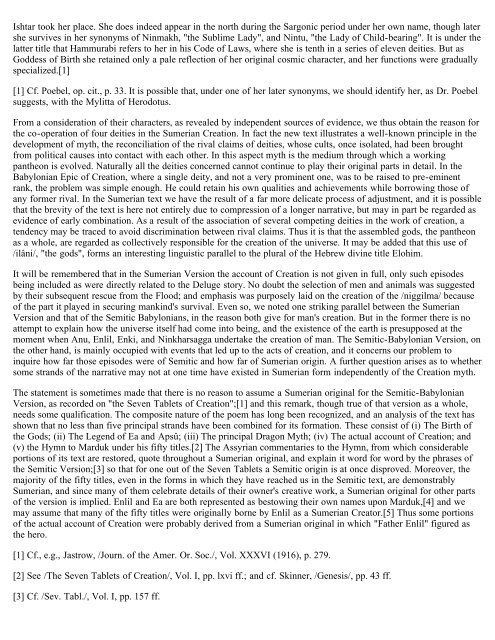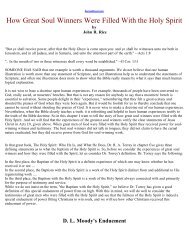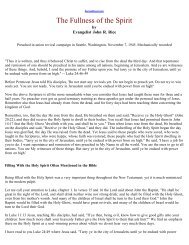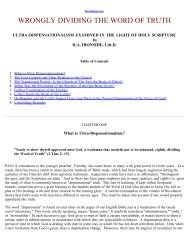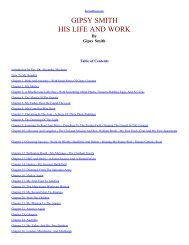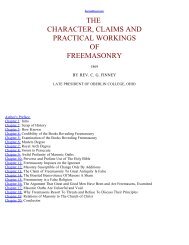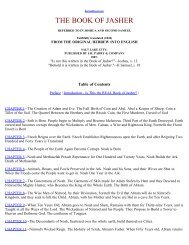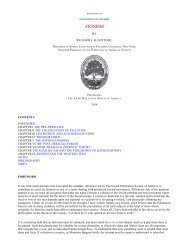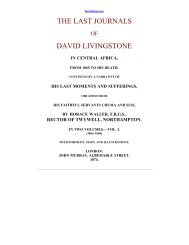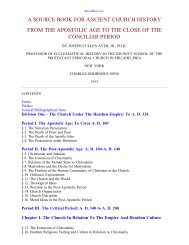Legends of Babylon and Egypt in Relation to Hebrew Tradition.pdf
Legends of Babylon and Egypt in Relation to Hebrew Tradition.pdf
Legends of Babylon and Egypt in Relation to Hebrew Tradition.pdf
Create successful ePaper yourself
Turn your PDF publications into a flip-book with our unique Google optimized e-Paper software.
Ishtar <strong>to</strong>ok her place. She does <strong>in</strong>deed appear <strong>in</strong> the north dur<strong>in</strong>g the Sargonic period under her own name, though later<br />
she survives <strong>in</strong> her synonyms <strong>of</strong> N<strong>in</strong>makh, "the Sublime Lady", <strong>and</strong> N<strong>in</strong>tu, "the Lady <strong>of</strong> Child-bear<strong>in</strong>g". It is under the<br />
latter title that Hammurabi refers <strong>to</strong> her <strong>in</strong> his Code <strong>of</strong> Laws, where she is tenth <strong>in</strong> a series <strong>of</strong> eleven deities. But as<br />
Goddess <strong>of</strong> Birth she reta<strong>in</strong>ed only a pale reflection <strong>of</strong> her orig<strong>in</strong>al cosmic character, <strong>and</strong> her functions were gradually<br />
specialized.[1]<br />
[1] Cf. Poebel, op. cit., p. 33. It is possible that, under one <strong>of</strong> her later synonyms, we should identify her, as Dr. Poebel<br />
suggests, with the Mylitta <strong>of</strong> Herodotus.<br />
From a consideration <strong>of</strong> their characters, as revealed by <strong>in</strong>dependent sources <strong>of</strong> evidence, we thus obta<strong>in</strong> the reason for<br />
the co-operation <strong>of</strong> four deities <strong>in</strong> the Sumerian Creation. In fact the new text illustrates a well-known pr<strong>in</strong>ciple <strong>in</strong> the<br />
development <strong>of</strong> myth, the reconciliation <strong>of</strong> the rival claims <strong>of</strong> deities, whose cults, once isolated, had been brought<br />
from political causes <strong>in</strong><strong>to</strong> contact with each other. In this aspect myth is the medium through which a work<strong>in</strong>g<br />
pantheon is evolved. Naturally all the deities concerned cannot cont<strong>in</strong>ue <strong>to</strong> play their orig<strong>in</strong>al parts <strong>in</strong> detail. In the<br />
<strong>Babylon</strong>ian Epic <strong>of</strong> Creation, where a s<strong>in</strong>gle deity, <strong>and</strong> not a very prom<strong>in</strong>ent one, was <strong>to</strong> be raised <strong>to</strong> pre-em<strong>in</strong>ent<br />
rank, the problem was simple enough. He could reta<strong>in</strong> his own qualities <strong>and</strong> achievements while borrow<strong>in</strong>g those <strong>of</strong><br />
any former rival. In the Sumerian text we have the result <strong>of</strong> a far more delicate process <strong>of</strong> adjustment, <strong>and</strong> it is possible<br />
that the brevity <strong>of</strong> the text is here not entirely due <strong>to</strong> compression <strong>of</strong> a longer narrative, but may <strong>in</strong> part be regarded as<br />
evidence <strong>of</strong> early comb<strong>in</strong>ation. As a result <strong>of</strong> the association <strong>of</strong> several compet<strong>in</strong>g deities <strong>in</strong> the work <strong>of</strong> creation, a<br />
tendency may be traced <strong>to</strong> avoid discrim<strong>in</strong>ation between rival claims. Thus it is that the assembled gods, the pantheon<br />
as a whole, are regarded as collectively responsible for the creation <strong>of</strong> the universe. It may be added that this use <strong>of</strong><br />
/ilâni/, "the gods", forms an <strong>in</strong>terest<strong>in</strong>g l<strong>in</strong>guistic parallel <strong>to</strong> the plural <strong>of</strong> the <strong>Hebrew</strong> div<strong>in</strong>e title Elohim.<br />
It will be remembered that <strong>in</strong> the Sumerian Version the account <strong>of</strong> Creation is not given <strong>in</strong> full, only such episodes<br />
be<strong>in</strong>g <strong>in</strong>cluded as were directly related <strong>to</strong> the Deluge s<strong>to</strong>ry. No doubt the selection <strong>of</strong> men <strong>and</strong> animals was suggested<br />
by their subsequent rescue from the Flood; <strong>and</strong> emphasis was purposely laid on the creation <strong>of</strong> the /niggilma/ because<br />
<strong>of</strong> the part it played <strong>in</strong> secur<strong>in</strong>g mank<strong>in</strong>d's survival. Even so, we noted one strik<strong>in</strong>g parallel between the Sumerian<br />
Version <strong>and</strong> that <strong>of</strong> the Semitic <strong>Babylon</strong>ians, <strong>in</strong> the reason both give for man's creation. But <strong>in</strong> the former there is no<br />
attempt <strong>to</strong> expla<strong>in</strong> how the universe itself had come <strong>in</strong><strong>to</strong> be<strong>in</strong>g, <strong>and</strong> the existence <strong>of</strong> the earth is presupposed at the<br />
moment when Anu, Enlil, Enki, <strong>and</strong> N<strong>in</strong>kharsagga undertake the creation <strong>of</strong> man. The Semitic-<strong>Babylon</strong>ian Version, on<br />
the other h<strong>and</strong>, is ma<strong>in</strong>ly occupied with events that led up <strong>to</strong> the acts <strong>of</strong> creation, <strong>and</strong> it concerns our problem <strong>to</strong><br />
<strong>in</strong>quire how far those episodes were <strong>of</strong> Semitic <strong>and</strong> how far <strong>of</strong> Sumerian orig<strong>in</strong>. A further question arises as <strong>to</strong> whether<br />
some str<strong>and</strong>s <strong>of</strong> the narrative may not at one time have existed <strong>in</strong> Sumerian form <strong>in</strong>dependently <strong>of</strong> the Creation myth.<br />
The statement is sometimes made that there is no reason <strong>to</strong> assume a Sumerian orig<strong>in</strong>al for the Semitic-<strong>Babylon</strong>ian<br />
Version, as recorded on "the Seven Tablets <strong>of</strong> Creation";[1] <strong>and</strong> this remark, though true <strong>of</strong> that version as a whole,<br />
needs some qualification. The composite nature <strong>of</strong> the poem has long been recognized, <strong>and</strong> an analysis <strong>of</strong> the text has<br />
shown that no less than five pr<strong>in</strong>cipal str<strong>and</strong>s have been comb<strong>in</strong>ed for its formation. These consist <strong>of</strong> (i) The Birth <strong>of</strong><br />
the Gods; (ii) The Legend <strong>of</strong> Ea <strong>and</strong> Apsû; (iii) The pr<strong>in</strong>cipal Dragon Myth; (iv) The actual account <strong>of</strong> Creation; <strong>and</strong><br />
(v) the Hymn <strong>to</strong> Marduk under his fifty titles.[2] The Assyrian commentaries <strong>to</strong> the Hymn, from which considerable<br />
portions <strong>of</strong> its text are res<strong>to</strong>red, quote throughout a Sumerian orig<strong>in</strong>al, <strong>and</strong> expla<strong>in</strong> it word for word by the phrases <strong>of</strong><br />
the Semitic Version;[3] so that for one out <strong>of</strong> the Seven Tablets a Semitic orig<strong>in</strong> is at once disproved. Moreover, the<br />
majority <strong>of</strong> the fifty titles, even <strong>in</strong> the forms <strong>in</strong> which they have reached us <strong>in</strong> the Semitic text, are demonstrably<br />
Sumerian, <strong>and</strong> s<strong>in</strong>ce many <strong>of</strong> them celebrate details <strong>of</strong> their owner's creative work, a Sumerian orig<strong>in</strong>al for other parts<br />
<strong>of</strong> the version is implied. Enlil <strong>and</strong> Ea are both represented as bes<strong>to</strong>w<strong>in</strong>g their own names upon Marduk,[4] <strong>and</strong> we<br />
may assume that many <strong>of</strong> the fifty titles were orig<strong>in</strong>ally borne by Enlil as a Sumerian Crea<strong>to</strong>r.[5] Thus some portions<br />
<strong>of</strong> the actual account <strong>of</strong> Creation were probably derived from a Sumerian orig<strong>in</strong>al <strong>in</strong> which "Father Enlil" figured as<br />
the hero.<br />
[1] Cf., e.g., Jastrow, /Journ. <strong>of</strong> the Amer. Or. Soc./, Vol. XXXVI (1916), p. 279.<br />
[2] See /The Seven Tablets <strong>of</strong> Creation/, Vol. I, pp. lxvi ff.; <strong>and</strong> cf. Sk<strong>in</strong>ner, /Genesis/, pp. 43 ff.<br />
[3] Cf. /Sev. Tabl./, Vol. I, pp. 157 ff.


